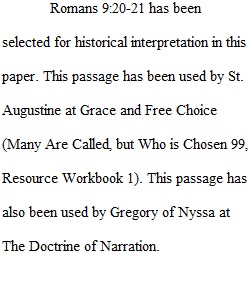


Q History of Interpretation Paper – 40% The history of interpretation paper will detail the use of a particular verse in Christian exegesis across the centuries. Students must choose one verse from the reading assignment for the first week. The history of interpretation paper must make use of sources that were assigned for class readings as well as sources that were not assigned. See the details provided further below. The final version of this paper should be 1500-2100 words (approximately 5-7 pages). You should plan to work with SmartThinking, our online tutoring service. Please plan ahead of time to make use of this resource and develop not only individual papers, but yourself as a writer. Students will select a single verse from the list of Scripture verses assigned as reading for the first week (excepting 1 Tim 2:4, which may not be chosen since various reading assignments in the course already cover this verse and students may write their argumentative essay on this verse). This paper should trace the history of the interpretation of the selected verse, noting at least two significant interpretations from assigned course readings and one significant interpretation from readings not assigned for this course. Sources used regularly in this course, like the Anchor Bible Commentary and Sacra Pagina will provide students with ample resources to find theologians not listed on the syllabus. Such commentaries do not count as significant interpretations for the history of interpretation paper. Some popular theologians who are not on the syllabus and would be helpful to complete the history of interpretation paper include St. Basil the Great, St. Cyril of Jerusalem, St Gregory the Great, St. Leo the Great, St. Bonaventure, St. Catherine of Siena, St. Julian of Norwich, Martin Luther, Huldrych Zwingli, Jonathan Edwards, John Wesley, Friedrich Schleiermacher, John Henry Newman, Karl Barth, and CS Lewis. Students must state their choice of a verse during the 4th week of class. This will be posted in a discussion board. A list of significant theologians and relevant passages within their literary corpus is due in the 5 th week of the course. This will be posted in the same discussion board. The final paper is due at the end of the 6 th week of the course. This will be submitted via the appropriate assignment. Submit the History of Interpretation Paper to Chalk and Wire no later than Sunday 11:59 EST/EDT of Module 6. The History of Interpretation Paper Chalk & Wire link is located in the Module 6 folder. Students who do not submit the assignment to Chalk & Wire will receive a zero. This is a key assignment assessment; the results are used to ensure students are meeting University Exploration program goals. Video and PDF instructions can be found on the course home page. PDF instructions are also located in the Start Here folder.
View Related Questions